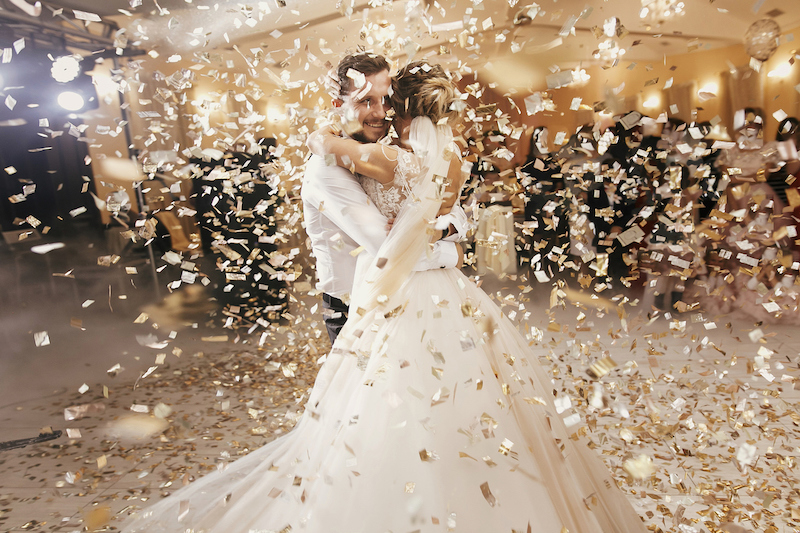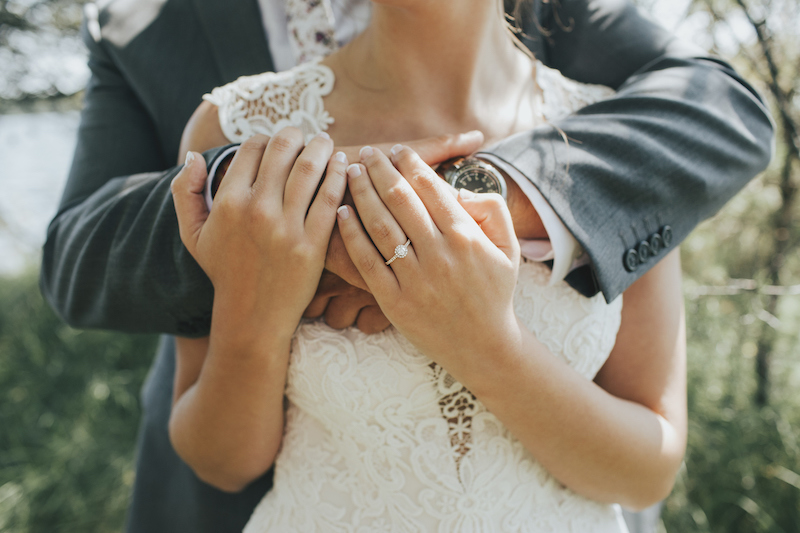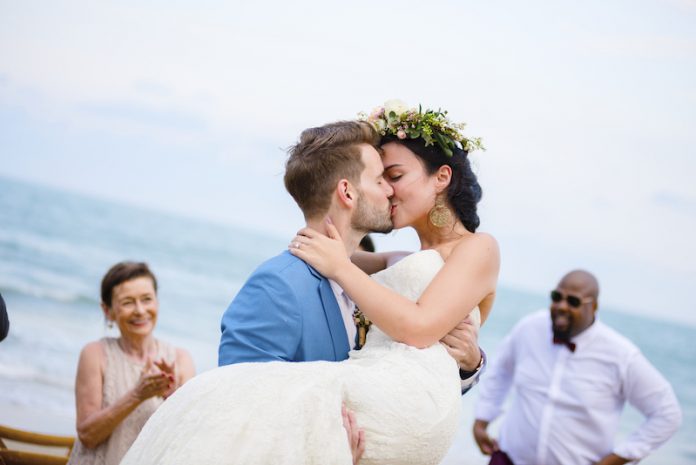According to the IMDB website, 72 movies since 2000 contain the word “wedding” in the title. The odds that you’ve watched at least one of them are high. And this focus on “weddings” is not limited to the movies. Against all the current trends dismissing “traditional” customs, weddings are still an integral milestone for most Americans. Even this article is proof that getting hitched remains an exciting topic for people. But here’s the question we all want to be answered: how much does a wedding cost?
What Do the Numbers Say?
Before we breakdown the average prices and budgets for a couple’s special day in 2019, let’s take a moment to explore current demographic data. Statistics show that the average age of someone’s first marriage has risen: 30 for men and 28 for women. The percentage of people that have never married in 2018 (32%) is nearly a tenth higher than the 23% in 1950.
Last year, single-person households represented almost a third of all households with 28%. In the 1960s, only 13 % of Americans were living alone. Moreover, the number of people living with an unmarried partner has also risen in recent years. Deposited all this data, however, marriage remains the “goal” for most couples living in America. If you’d like to explore the data further and compare your generation’s lifestyle with that of your grandma, then check out the Census Bureau website, which has data as far back the 1940s.
Suggested Reading: Best Savings Accounts for July, 2020
How Much Does an Average Wedding Cost?
Generating a number is easy, but understanding it is more difficult because existing statistical data on the average costs of the special event – from the reception to the flowers – is disputable.
The Knot 2018 Real Weddings Study surveyed 14,000 married couples and concluded that the average amount they spend on their wedding is $33,931. This number doesn’t include the budget for a honeymoon.
According to another source, the Wedding Wire, the average price to pay for a wedding in America is $38,700 (this time with the honeymoon included). Their number comes from the feedback of 18,000 couples.
But wait! Another recent surgery by the Wedding Report states $24,723 as the average wedding cost (sans honeymoon) in 2018.
Now it is important to note that the first two reports are produced by wedding planning companies, while the third one studies the wedding market. Whichever statistic you accept, it tells you nothing more than just a neat number that may or may not be helpful in the long run, especially if you or someone you know plans to budget for a wedding. Here’s why.
Fuzzy Math
With more than two million weddings in 2018, it is easy for the data to get skewed with such a large sample size. For example, let’s say most people spend around $15,000. Then, a small number of couples enjoy a modest reception costing no more than $5,000. Finally, some will get their dream wedding and spend over a million-dollar budget. It’s all relative to a couple’s financial health.
The last group of weddings, dream weddings, is probably the smallest. But because the number is so high, it strongly influences the average costs by steering it towards a higher amount. Consequently, without seeing the actual data from a study and understanding how the extremes affect the mean, the final” average” number is meaningless.
Now that the fine print and glossy headlines are covered, the question remains: How much does a wedding cost?
Suggested Reading: You Always Remember Your First Time: How to Buy a Car
Wedding Categories
Once the word “wedding” pops up, almost everybody has specific images in their heads. Your imagination takes off and goes in multiple directions: attire, ceremony, cocktails, flowers, cake, music, decorations, etc. To help reign this in and provide clarity, we provide a list of “typical” expense categories for a wedding. There are also suggestions for a category’s proportion in an overall budget. This way, you can estimate how much you can afford for the wedding venue or rehearsal dinner based on the money you want to spend.
The list isn’t exhaustive; it merely serves a guide for the “typical” American wedding, and it is derived from qualitative (personal experiences) and quantitative (wedding planner websites) data. So, without further ado, I now pronounce you…

Reception Costs – 42-50%
Roughly half of what you will have to pay for your entire wedding goes to cover the expenses for venue and catering. Sometimes, the costs could reach the level of a down payment for a mortgage. Food and drinks might be part of an in-house offer if you go with a more traditional wedding site. Should you decide for something little less conventional, you will have to hire a caterer to take care of the food and the open bar. Some venues take care of all decorations, while others leave this part to you.
Ceremony (venue, music, and fees) – 4-5%
You can go with a wedding and reception at the same site or have the service in a church or official hall. Do you plan to have musicians playing live during the wedding ceremony? And don’t forget about the fees to pay for a marriage license and other related documents.
Suggested Reading: Parenting Money Tips – Parenting Doesn’t Mean Spending
Rehearsal Dinner – 6%
Usually, the rehearsal dinner gathers only the bride, groom, and the closest friends and family. Still, you will have to pay for the food and drinks.
Reception Music – 4-6%
Options typically include live music or a wedding DJ. Of course, you can also choose to rent equipment and play your playlist.
Wedding Photographer – 8-10%
Even in the era of smartphones with amazing cameras, people still prefer to rely on a professional. After all, a photographer trains their eyes to catch those special and intimate moments that make a picture meaningful and exciting. And a team of two can record events happening simultaneously. When hiring a photographer, don’t forget to ask if the price includes prints. More important, find out if you will pay a preset packaged price or an hourly rate.
Videographer – 5%
Nowadays, recording the most memorable moments of the wedding with cool aerial sequences, professional editing, and captivating sound effects is another must. And the better the quality you expect, the higher the price will be.
Flowers & decorations – 6%
A wedding without flowers seems incomprehensible to most people, so even a modest bridal bouquet will factor into the expenses. There are also the bride’s maids’ flowers, table centerpieces, venue decorations, etc. The flower budget line is often overlooked but ends up costing a sizable sum.
Suggested Reading: What’s Hot in Technology This Year
Favors and Gifts – 2%
Remember those little take-home gifts, such as small wine bottles and picture frames, that are meant to mind you of the couple’s joyous event? Did you keep them? Of course not, but they are a staple of weddings. So, budget some money for those throw-away gifts.
Transportation – 2%
Are the ceremony and reception in the location? Will close family and friends be traveling long distances? Will there be an open bar at your reception? If you answered “yes” to any of those, then don’t forget to plan for adequate transportation.
Attire – 8%
When someone says “wedding,” the first thing to pop into your mind is the bride’s dress. And is it ever a pricey part of an American wedding, sometimes exceeding thousands and thousands of dollars. Let’s not forget about the bride’s maid’s dresses too. The costs of wedding attire can quickly skyrocket.
Rings – 5-8%
No ring, no wedding – it’s the quintessential symbol of the entire ceremony. Even if you decide to use a piece of family jewelry, you will still have costs for the adjustments.

Wedding Invitations – 2%
Whether you go with custom designed prints or one of the existing samples, there will be printing and posting costs. There is also the alternative option to consider – setting up an RSVP website or email invites. Managing any option will cost you either money or time.
Wedding planner – 8-10%
A professional wedding coordinator is ideal if you don’t want the hassle of organizing, scheduling, and stressing every part of a wedding ceremony. Keep in mind that not every wedding requires elaborate planning, so you may not need this category.
Hair and makeup – 2%
The wedding couple’s appearance is as expensive as it is necessary. Additional costs might arise if you plan to cover the beauty services for the bride’s maids too.
Cake – 2%
Typically, prices here are per piece, but there are also expenses related to decorations. Yes, those little bride and groom figures on top of most wedding cakes cost money.
Miscellaneous – 5 %
Your wedding might require something special and unique to you, so consider the 5% a budget for that item or a buffer in case something else is more expensive.
The Happy Day
The above list contains items that Americans are used to seeing at weddings, whether real ones or fantasy ones in Hollywood. (Note that it does not include anything honeymoon related.). Feel free to discard or add categories based on your needs and preferences for your happy day.
It is common for people to tie the knot under pressure, pressure from family, pressure from friends, even pressure from society. Sometimes couples survey the wedding reception and ask themselves, “How did this happen? We wanted a small, intimate wedding?” Don’t be that couple. Plan.
Suggested Reading: Real Work-From-Home Jobs and How to Get Started
How to Reduce Wedding Expenses
Below you’ll find some pragmatic recommendations if you want to save money. They apply to both traditional and unconventional weddings.
1. Set a Budget
Start by identifying who is paying for the marriage. Customarily, the bride’s parents are the ones who take care of the financial burden of tying the knot. However, nowadays, couples often contribute to paying the wedding bills. Also, guests can be encouraged to contribute instead of buying a wedding gift. Once you have built your budget, you are ready for the next steps.
Suggested Reading: How to Build a Budget: Step by Step
2. Prioritize
It’s crucial for the bride and groom to sit down and talk about what they want and expect from the wedding. Define up to three main areas with which you won’t make any compromise. For some, it might be live music, while for others, it could be the guest list size. Do the same assessment about questions that bother you the least.
Suggested Reading: Got a Sad Wallet? Here’s How to Make Money
3. Fewer Guests
One of the easiest ways to lower your costs is by cutting the number of guests. Planning food and drinks for 150 versus 100 people is already a substantial difference. Use budgeting apps to generate multiple estimates based on the number of guests attending.
4. Choose Your Date and Time Wisely
There is a season for everything, and you can consider an off-season wedding. If you want to trim some expenses, forget about a wedding in June or September. Saturday is also more expensive than Friday, Sunday or any other day of the week. A wedding during the day will probably be more affordable than an evening one.
5. DJ vs. Band
Wedding bands are always pricier than hiring a DJ. An even cheaper option is to make your playlist and plug your iPod in the sound equipment – don’t forget to calculate the costs for renting the sound system.
6. Use Online Tools
In 2019, you can easily skip printed invitations and email invites. Even better – build a wedding website with embedded RSVP forms.

Suggested Reading: How to Save Money: Simple Steps to Overcoming Debt
7. Go Green to Save Green
Hosting a “green” wedding doesn’t mean serving overpriced organic vegan food or ordering upscale ethically produced attire from the other side of the world. It means being environmentally friendly by using fewer resources and providing little to no waste. The added benefit of this type of ceremony is that it will cost you less money.
8. Keep It Simple, Seasonal, and Local
We are referring to the venue, food, flowers, and hired help. It will do wonders for your budget.
9. CrowdSource
Engage your family and friends in the organization of the wedding. Maybe somebody could take the role of the DJ at the wedding party? Another friend could set up and follow your wedding website. The creative fellows could do original hand-made favors. The talented could give a hand by singing a song or preparing the cake. Contributing to your day will make people feel it is even more special. If you have a business-savvy person, ask them to help with financial planning.
10. Reduce waste
Zero Waste might be a bit challenging, though not unachievable. Start by not producing objects that will serve their purpose for less than a couple of hours. If it is necessary to obtain a new product, think of how you can make it useful again later. For example, you can donate your wedding dress for a good cause. Or the favors could be something that people will keep, reuse, or eat. Potted flowers are a great decoration. Also, avoid plastic packaging and single-use utensils. The latter might be a bit challenging and expensive, but it is worth it.
Suggested Reading: How to Pay for College in 9 Steps
Final Thoughts
So, after analyzing all the data, generating a list of traditional wedding categories, and suggesting ways to reduce overall costs, it is time to answer the big question: How much does a wedding cost? The answer is a resounding, “Who knows?” A wedding costs whatever you want it to cost. Who cares about what a wedding should have? It’s your wedding; you decide because the highest cost of a wedding shouldn’t be your happiness.
Suggested Reading: Cloud Computing Management: All You Ever Wanted to Ask

